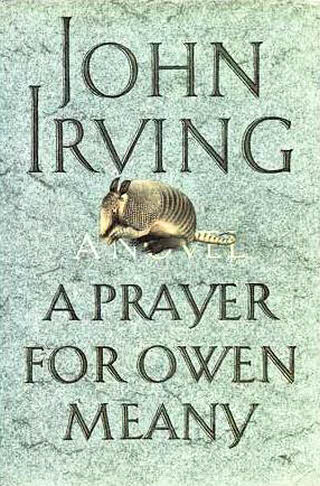 I’m not really going to review this twenty-seven-year-old book that I’m guessing thousands of professional reviewers have written millions of words about. When I first read it, more than two decades ago, I thought it was one of the best books I had ever encountered. A recent re-read only reinforced that. The re-read was prompted by plans to attend a performance of a play based on the novel. I’m going to say some things about that performance but this really isn’t a review of it either. In fact, I find myself stumped in trying to explain just exactly what this is. Whatever it is, it was triggered by my recent experience with a book and a play.
I’m not really going to review this twenty-seven-year-old book that I’m guessing thousands of professional reviewers have written millions of words about. When I first read it, more than two decades ago, I thought it was one of the best books I had ever encountered. A recent re-read only reinforced that. The re-read was prompted by plans to attend a performance of a play based on the novel. I’m going to say some things about that performance but this really isn’t a review of it either. In fact, I find myself stumped in trying to explain just exactly what this is. Whatever it is, it was triggered by my recent experience with a book and a play.
From the moment I saw that Cincinnati’s Playhouse in the Park would be presenting A Prayer for Owen Meany I wanted to see it. I knew nothing about the play but recalled how much I loved the book. As is often the case, I recalled my love of the book better than I recalled the details of it and decided that reading it again would be a wise move. I reserved a digital copy at the library but the Playhouse’s announcement had obviously given others the same idea. The waiting list was long and it moved slowly. It became apparent that I might not even receive a copy before I saw the play let alone have time to read it. I turned to Amazon where money solved the problem. A little more money provided a new experience.
When I purchased a Kindle version of the book, I was given the option of adding an audio version from Audible for a few dollars more. I bit, thinking that it might help me get through the book before showtime. It did. The two versions were synchronized so that I could listen as I walked to a nearby restaurant, read while I ate, then listen some more as I walked home with Kindle picking up where Audible left off and vice versa. I don’t think it will become my default method of “reading” but it is a very effective way of using all available minutes to move forward.
So I finished the book and made it to the play. I have no illusions that a play or movie can be a complete replacement for a well-written book but I do know that a well-done play or movie can sometimes cut through minutia while preserving a theme and making it more easily accessible to more people. This was not, in my opinion, one of those times.
First, in defense of the production, the Playhouse cast and staff did an admirable job in staging and performing a complex script. Second, in defense of the playwright, the novel itself is certainly complex with loads of characters and locations, multiple time periods, and a narrator whose inner thoughts sort of fuel the whole thing. That this is built atop a doubly volatile core of both politics and religion no doubt makes a stage adaptation quite challenging.
I’ve just one knock on the production. The acting was excellent as was the use of space. The flying, however, wasn’t so good. The script (I assume) calls for Owen Meany to go airborne several times in a Mary Martin/Peter Pan sort of way. The problem was that, before each lift-off, actors spent on-stage time connecting the support apparatus to Owen’s body. The audience was left with a more vivid memory of the preparation than of the “flight”.
That aspects of the novel needed to be eliminated in a stage play goes without question. I don’t even question screenwriter Simon Bent’s choices of what to eliminate. Big stuff from the book that didn’t make it to the stage include John Wheelwright’s three cousins, his lengthy comments on the Iran-Contra affair, and the removal of his finger to avoid the draft. The armadillo that soloed on the cover of the first edition didn’t make it to the stage either. Nor did Owen Meany’s time as The Voice or his conflicts with school administration that cost him scholarships and led to his enrollment in ROTC. I recognize the fact that to include these or some of the many other things eliminated might have complicated things beyond reason. Whether or not the simplification made the play accessible and understandable to anyone unfamiliar with the book is not for me to say.
I expect things to be simplified when a book goes to the stage or screen. Not only must things be eliminated but sometimes things must be simply changed. Changing the armadillo to a ball and glove makes sense. Adding the Lenny Bruce scene as a device to express some inner thoughts is reasonable. But why change the day of Owen’s death? I don’t think it’s particularly important in the book. There it is July 8 and a follow on to Independence Day but is not, as far as I can tell, otherwise significant. If there is a purpose to changing it to March 31 in the play, it’s lost on me. And it’s irritating.
The majority of comments on the Playhouse’s Facebook page are positive. Some are glowing. Only a few are really negative. Some mention language, others the flying apparatus, and some give no reason at all. It would not have surprised me if people who had not read the book found the play hard to follow but that doesn’t seem to be the case. I only spotted a couple of comments suggesting that. More common are comments from people who intend to read the book now that they’ve seen the play. That’s a good thing, I think, because I believe they’ll find that a picture — even a moving picture — isn’t always worth a thousand words.
Added 21-Sep-2016 8:00: A Prayer for Owen Meany begins with the narrator stating “I am a Christian because of Owen Meany.” Questioning then embracing faith is the book’s most basic theme. What I’ve personally questioned is my attraction to a book whose message seems so different from what I believe. Skillful writing and the fact that it makes me think must be the reasons. The following quote from John Irving makes me much more comfortable with my admiration for a book that seems almost an endorsement of Christianity.
I’m not religious. In writing “A Prayer for Owen Meany,” I asked myself a fairly straightforward question — namely, what would it take to make a believer out of me? The answer is that I would have to meet someone like Owen Meany. If I’d had Johnny Wheelwright’s experience in that novel, I would probably be a believer too. But I haven’t had that experience — I only imagined it.
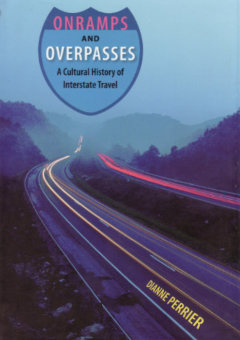 You can’t judge a book by looking at the cover. Or, sometimes, by reading the title. That was the case for me with Onramps and Overpasses and the impression I got from the title and cover pretty much explains why it stayed on the unread pile so long that I don’t remember where it came from or why I have it. The cover is a nicely done long exposure photo of cars on a divided four-lane highway passing through what looks to be a rather scenic area. The title reinforces the image of high-speed limited-access roadways. The subtitle, “A Cultural History of Interstate Travel” does a better job of describing what’s inside but the preconception created by the cover and title led me to overlook the word “cultural” and misinterpret the word “interstate”. In my opinion, Perrier goofed on the cover and even more so on the title. Those are, however, virtually the only mistakes she makes here.
You can’t judge a book by looking at the cover. Or, sometimes, by reading the title. That was the case for me with Onramps and Overpasses and the impression I got from the title and cover pretty much explains why it stayed on the unread pile so long that I don’t remember where it came from or why I have it. The cover is a nicely done long exposure photo of cars on a divided four-lane highway passing through what looks to be a rather scenic area. The title reinforces the image of high-speed limited-access roadways. The subtitle, “A Cultural History of Interstate Travel” does a better job of describing what’s inside but the preconception created by the cover and title led me to overlook the word “cultural” and misinterpret the word “interstate”. In my opinion, Perrier goofed on the cover and even more so on the title. Those are, however, virtually the only mistakes she makes here.
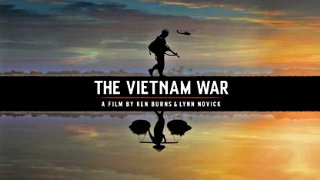






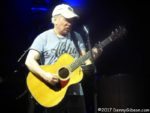
 I’ve not read a lot of fiction lately. I used to. There was a time when I sucked down a fair amount of science fiction and historical fiction along with a smattering of aged classics. Sorry’s Run is none of those. It is, however, just about everything else. If pressed to place it under a single heading, I guess I’d call it a mystery. It’s a mystery where learning what was done is at least as much fun as learning who done it. Beneath the book’s central plot is an intriguing layer of occult, a tolerable touch of romance, and frequent and appreciative glimpses of the Ohio River and the country it flows through. It is set in the real world of today although it’s a world whose edges are not always crisply defined.
I’ve not read a lot of fiction lately. I used to. There was a time when I sucked down a fair amount of science fiction and historical fiction along with a smattering of aged classics. Sorry’s Run is none of those. It is, however, just about everything else. If pressed to place it under a single heading, I guess I’d call it a mystery. It’s a mystery where learning what was done is at least as much fun as learning who done it. Beneath the book’s central plot is an intriguing layer of occult, a tolerable touch of romance, and frequent and appreciative glimpses of the Ohio River and the country it flows through. It is set in the real world of today although it’s a world whose edges are not always crisply defined.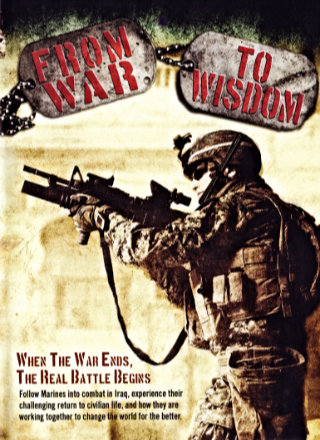 I might not even be aware of this movie’s existence if I didn’t know one of the directors. Maybe someone else will learn of it only because they know me. If so, that’s a good thing. And it’s also a good thing if someone learns of the movie by stumbling onto this blog post without knowing either of us. If either of those things happens and someone watches
I might not even be aware of this movie’s existence if I didn’t know one of the directors. Maybe someone else will learn of it only because they know me. If so, that’s a good thing. And it’s also a good thing if someone learns of the movie by stumbling onto this blog post without knowing either of us. If either of those things happens and someone watches 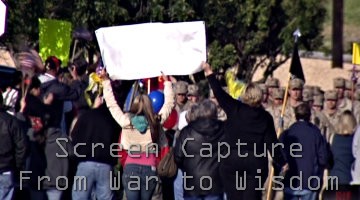 Creating a marker between the halves is a text only shot. In front of the shot we see returning soldiers marching between welcoming signs and banners then being dismissed to reunite with their families while veteran Hans Palmer describes the time as “the proudest I’ve ever felt in my life.” Following the text is a scene with Josh Hisle talking about needing a “place to decompress — every day.” He’s sitting outside his apartment waiting for everyone else in the complex — his “area” — to go to sleep. “It’s not insomnia,” he says. “It’s duty.”
Creating a marker between the halves is a text only shot. In front of the shot we see returning soldiers marching between welcoming signs and banners then being dismissed to reunite with their families while veteran Hans Palmer describes the time as “the proudest I’ve ever felt in my life.” Following the text is a scene with Josh Hisle talking about needing a “place to decompress — every day.” He’s sitting outside his apartment waiting for everyone else in the complex — his “area” — to go to sleep. “It’s not insomnia,” he says. “It’s duty.”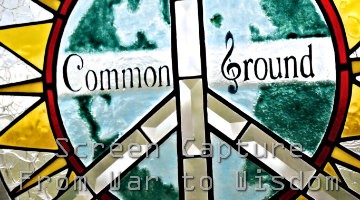 There are many other examples of veterans helping veterans both in the film and out. They are bright spots and their successes are to be celebrated but they aren’t enough to make From War to Wisdom a feel good movie. It is, however, an encouraging movie and an informative one. Most of the veterans that appear in the film fought in either Afghanistan or Iraq. There is one notable exception. He’s a Vietnam vet who’s legal name is now Ragtime. He is a stained glass artist who teaches at Common Ground and started
There are many other examples of veterans helping veterans both in the film and out. They are bright spots and their successes are to be celebrated but they aren’t enough to make From War to Wisdom a feel good movie. It is, however, an encouraging movie and an informative one. Most of the veterans that appear in the film fought in either Afghanistan or Iraq. There is one notable exception. He’s a Vietnam vet who’s legal name is now Ragtime. He is a stained glass artist who teaches at Common Ground and started  The review of this book published in April 2017 has gone missing. Maybe I accidentally deleted it or maybe a slightly down level backup was restored and I didn’t notice. Whatever happened, I’m confident it was my fault. I’m not going to try to reproduce the whole review. I’m just trying to head off the “not found” errors — and encourage everyone to buy a copy.
The review of this book published in April 2017 has gone missing. Maybe I accidentally deleted it or maybe a slightly down level backup was restored and I didn’t notice. Whatever happened, I’m confident it was my fault. I’m not going to try to reproduce the whole review. I’m just trying to head off the “not found” errors — and encourage everyone to buy a copy. This book was first published in 1890. The link at the end of this article points to a version published barely a month ago. Despite it being well over a century old, some think it worth reading and someone considers it worth republishing. Why others consider the 127 year old writing worth reading I cannot say but I know why I enjoyed it. It’s filled with stories I’ve watched unfold on TV or in a movie theater or read as fiction. Those tales of frightened town folk, evil bullies, crooked sheriffs, and cowardly henchmen that thrilled me in my younger days were all legitimate. The basis of many plots played out in the numerous TV westerns of the 1950s and ’60s can be recognized in the real world events that Langford documents. This book is filled with characters very much like the assorted outlaws encountered by the horse riding heroes of my youth. Men similar to some of those heroes are also present although they don’t stand out quite as clearly. Few real world heroes wear a pair of pearl handled revolvers and a white hat.
This book was first published in 1890. The link at the end of this article points to a version published barely a month ago. Despite it being well over a century old, some think it worth reading and someone considers it worth republishing. Why others consider the 127 year old writing worth reading I cannot say but I know why I enjoyed it. It’s filled with stories I’ve watched unfold on TV or in a movie theater or read as fiction. Those tales of frightened town folk, evil bullies, crooked sheriffs, and cowardly henchmen that thrilled me in my younger days were all legitimate. The basis of many plots played out in the numerous TV westerns of the 1950s and ’60s can be recognized in the real world events that Langford documents. This book is filled with characters very much like the assorted outlaws encountered by the horse riding heroes of my youth. Men similar to some of those heroes are also present although they don’t stand out quite as clearly. Few real world heroes wear a pair of pearl handled revolvers and a white hat. I’ve never met Jaimie Vernon but we’re friends. We’re the kind of friends that didn’t even exist a dozen years ago. Yes, we’re Facebook friends. It’s because of music. Vernon runs Bullseye Records which represented the band Klaatu through part of their career. I’m a Klaatu fan and stumbled onto a related online group in which Vernon played an active role. The e-group eventually became more or less dormant but we remained e-friends in the Facebook world. I’m sharing this, not because it has anything to do with the contents of this book, but to explain how I even know of the book’s existence. I am not in the habit of chasing down either cop books or cemetery stories.
I’ve never met Jaimie Vernon but we’re friends. We’re the kind of friends that didn’t even exist a dozen years ago. Yes, we’re Facebook friends. It’s because of music. Vernon runs Bullseye Records which represented the band Klaatu through part of their career. I’m a Klaatu fan and stumbled onto a related online group in which Vernon played an active role. The e-group eventually became more or less dormant but we remained e-friends in the Facebook world. I’m sharing this, not because it has anything to do with the contents of this book, but to explain how I even know of the book’s existence. I am not in the habit of chasing down either cop books or cemetery stories. It’s exactly what you’d expect. That’s not to say that there is no new information and no surprises but the sometimes almost poetic writing style is exactly what I expected from a man who has produced some of the most notable English language lyrics of the last four decades. It’s no secret that some of those lyrics were just a bit autobiographical so it’s possible to think of this as sort of a much longer and more detailed version of the story he’s been singing since he first greeted us from Asbury Park.
It’s exactly what you’d expect. That’s not to say that there is no new information and no surprises but the sometimes almost poetic writing style is exactly what I expected from a man who has produced some of the most notable English language lyrics of the last four decades. It’s no secret that some of those lyrics were just a bit autobiographical so it’s possible to think of this as sort of a much longer and more detailed version of the story he’s been singing since he first greeted us from Asbury Park. I’m not really going to review this twenty-seven-year-old book that I’m guessing thousands of professional reviewers have written millions of words about. When I first read it, more than two decades ago, I thought it was one of the best books I had ever encountered. A recent re-read only reinforced that. The re-read was prompted by plans to attend a performance of a play based on the novel. I’m going to say some things about that performance but this really isn’t a review of it either. In fact, I find myself stumped in trying to explain just exactly what this is. Whatever it is, it was triggered by my recent experience with a book and a play.
I’m not really going to review this twenty-seven-year-old book that I’m guessing thousands of professional reviewers have written millions of words about. When I first read it, more than two decades ago, I thought it was one of the best books I had ever encountered. A recent re-read only reinforced that. The re-read was prompted by plans to attend a performance of a play based on the novel. I’m going to say some things about that performance but this really isn’t a review of it either. In fact, I find myself stumped in trying to explain just exactly what this is. Whatever it is, it was triggered by my recent experience with a book and a play.